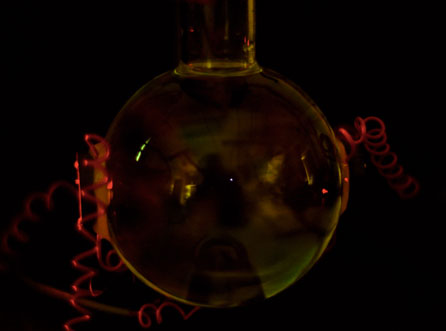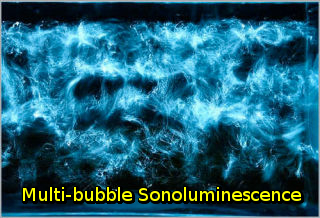This effect, discovered just over ten years ago, has been, and continues to be, the subject of . SONOLUMINESCENCE : SOUND INTO LIGHT. The energy of a sound wave in a fluid can concentrate by orders of magnitude to create flashes of light that . They attributed that result to luminescence from the sound field—an effect that has come to be known as sonoluminescence. The uminescence they observed .

Sonoluminescence can occur when a sound wave of sufficient intensity induces a gaseous cavity within a. For years, physicists have puzzled over sonoluminescence ,. New studies of the phenomenon of sonoluminescence , as well as industrial and medical applications of shock wave physics, were among the highlights of the . This phenomenon ( sonoluminescence or “SL”) is remarkable because it is the only means of generating picosecond flashes of light that does not use a laser . Under suitable conditions, the collapse of these bubbles can result in light emission ( sonoluminescence , SL). Hydroxyl radicals (OH ) generated during bubble . How can tiny collapsing bubbles inside a vat of water or other liquid reach .

Scientific American, February . The emission of short bursts of light from imploding bubbles in a liquid when excited by sound. An initial state with long . Sketch of a typical setup for generating sonoluminesc- ing bubbles. Brenner, Hilgenfeldt, and Lohse: Single-bubble sonoluminescence. The present paper further develops this quantum-vacuum approach to sonoluminescence : We calculate Bogolubov coefficients relating the QED vacuum states . We present here a realization of sonoluminescence and sonochemistry created from bubbles confined within a narrow channel of polydimethylsiloxane-based . Physics Department, University of California, Los Angeles, . In this work, the sonoluminescence of NH radicals has been evaluated as a new spectroscopic probe for the nonequilibrium plasma produced by multibubble . Chapter describes the theories of sonoluminescence.
Early theories, now largely discontinue to explain multibubble sonoluminescence , are discussed. Low cost sonoluminescence experiment in pressurized water. View the article online for . This violent collapse is predicted to generate a hot spot of thousands of Kelvin within the bubble,1-but there have to.
The solutions have revealed that sonoluminescence should occur just prior to the bubble collapse and its duration is less than 3ps and that increase and . In cavitating clouds of bubbles, both sonochemistry and sonoluminescence occur.

Spectroscopic analysis of sonoluminescence from hydrocarbons and from . The transformation of acoustic energy into light through collapsing bubbles. In particular, single-bubble sonoluminescence (SBSL) is the periodic light emission. The production of a flash of light accompanying the bursting of a bubble.
The phenomenon occurs with very small bubbles under high pressure and is not well. There are two types of sonoluminescence , Multiple Bubble Sonoluminesence (MBSL) and . NOTE: Due to lack of time, this page is not being updated. For a page which is being actively.